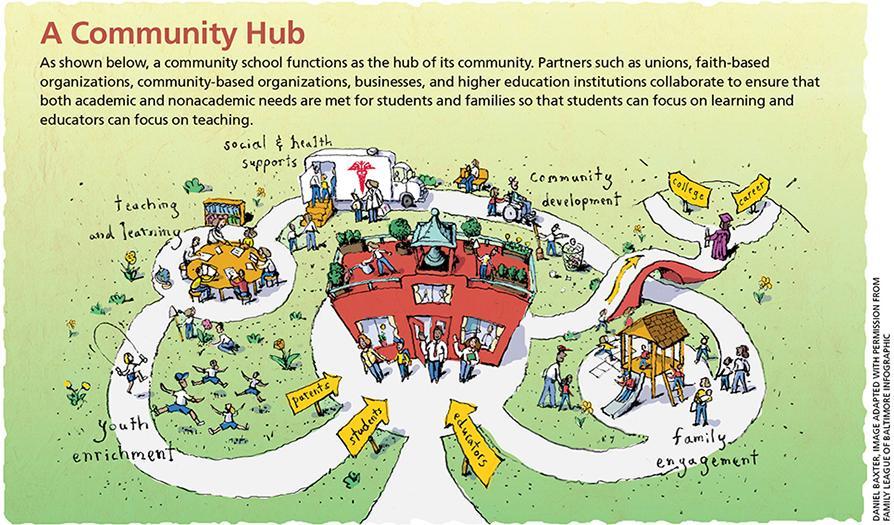The Community Schools Model
Background
Originating from the progressivism movement of the early twentieth century, the Community Schools Model approaches schools as “community social centers,” striving to address the needs of a community beyond the traditional role of schools. Social reformers of the late nineteenth and early twentieth centuries saw schools as the ideal place for these social centers. They believed that schools should be the center of a community, providing beneficial social services and serving as a place for intra-community dialogue. Throughout the twentieth century, community schooling saw several eras of resurgence in different iterations, adjusting to the unique circumstances of unique eras and communities, demonstrating the potential of the model to be a dynamic tool to address the issues and problems facing individual communities.

The community schools of today work to build partnerships between the school and other actors in a community, such as “higher education institutions, government health and social service agencies, community-based nonprofits, and faith-based organizations.” These partnerships strive to create structures developed to improve the learning conditions experienced by students in the schools, with the goal of creating an environment similar to those experienced by students from more privileged backgrounds. Community schools also engage parents, both as partners and as learners, providing them with educational resources in addition to community engagement opportunities.
Community Schools in Practice
"Community schools are grounded in the principle that all students, families, and communities benefit from strong connections between educators and local resources, supports, and people."
Community schools operate in diverse and varied settings; however, all community schools operate with four features, known as the four pillars of community schools:
- Integrated student supports
- Expanded learning time and opportunities
- Family and community engagement
- Collaborative leadership and practice
These pillars strive to create educational environments with “meaningful learning opportunities, high quality teaching, well-used resources, additional supports, and a culture of high expectations, trust, and shared responsibility.” These conditions enable students’ “intellectual, social, emotional, and physical” development.

Research has shown that community schools improve outcomes and better meet the needs of “low-achieving students in high-poverty schools.” Community schools have the potential to dramatically change the lives of their students and families, providing them with development and community opportunities that have historically only been available to more privileged students. These supports enable student success and promote positive conditions in the school and the broader community.
Source: Learning Policy Institute: Community Schools As An Effective School Improvement Strategy
Background
Originating from the progressivism movement of the early twentieth century, the Community Schools Model approaches schools as “community social centers,” striving to address the needs of a community beyond the traditional role of schools. Social reformers of the late nineteenth and early twentieth centuries saw schools as the ideal place for these social centers. They believed that schools should be the center of a community, providing beneficial social services and serving as a place for intra-community dialogue. Throughout the twentieth century, community schooling saw several eras of resurgence in different iterations, adjusting to the unique circumstances of unique eras and communities, demonstrating the potential of the model to be a dynamic tool to address the issues and problems facing individual communities.

The community schools of today work to build partnerships between the school and other actors in a community, such as “higher education institutions, government health and social service agencies, community-based nonprofits, and faith-based organizations.” These partnerships strive to create structures developed to improve the learning conditions experienced by students in the schools, with the goal of creating an environment similar to those experienced by students from more privileged backgrounds. Community schools also engage parents, both as partners and as learners, providing them with educational resources in addition to community engagement opportunities.
Community Schools in Practice
"Community schools are grounded in the principle that all students, families, and communities benefit from strong connections between educators and local resources, supports, and people."
Community schools operate in diverse and varied settings; however, all community schools operate with four features, known as the four pillars of community schools:
- Integrated student supports
- Expanded learning time and opportunities
- Family and community engagement
- Collaborative leadership and practice
These pillars strive to create educational environments with “meaningful learning opportunities, high quality teaching, well-used resources, additional supports, and a culture of high expectations, trust, and shared responsibility.” These conditions enable students’ “intellectual, social, emotional, and physical” development.

Research has shown that community schools improve outcomes and better meet the needs of “low-achieving students in high-poverty schools.” Community schools have the potential to dramatically change the lives of their students and families, providing them with development and community opportunities that have historically only been available to more privileged students. These supports enable student success and promote positive conditions in the school and the broader community.
